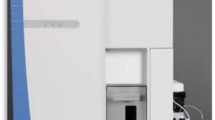Abstract
Proton transfer reaction mass spectrometry (PTR-MS) is a well-established technique for real-time analysis of volatile organic compounds (VOCs). Although it is extremely sensitive (with sensitivities of up to 4500 cps/ppbv, limits of detection <1 pptv and the response times of approximately 100 ms), the selectivity of PTR-MS is still somewhat limited, as isomers cannot be separated. Recently, selectivity-enhancing measures, such as manipulation of drift tube parameters (reduced electric field strength) and using primary ions other than H3O+, such as NO+ and O2 +, have been introduced. However, monoterpenes, which belong to the most important plant VOCs, still cannot be distinguished so more traditional technologies, such as gas chromatography mass spectrometry (GC-MS), have to be utilised. GC-MS is very time consuming (up to 1 h) and cannot be used for real-time analysis. Here, we introduce a sensitive, near-to-real-time method for plant monoterpene research—PTR-MS coupled with fastGC. We successfully separated and identified six of the most abundant monoterpenes in plant studies (α- and β-pinenes, limonene, 3-carene, camphene and myrcene) in less than 80 s, using both standards and conifer branch enclosures (Norway spruce, Scots pine and black pine). Five monoterpenes usually present in Norway spruce samples with a high abundance were separated even when the compound concentrations were diluted to 20 ppbv. Thus, fastGC-PTR-ToF-MS was shown to be an adequate one-instrument solution for plant monoterpene research.




Similar content being viewed by others
References
Bäck J, Aalto J, Henriksson M et al (2012) Chemodiversity of a Scots pine stand and implications for terpene air concentrations. Biogeosciences 9:689–702. doi:10.5194/bg-9-689-2012
Janson RW (1993) Monoterpene emissions from Scots pine and Norwegian spruce. J Geophys Res Atmos 98:2839–2850. doi:10.1029/92JD02394
Räisänen T, Ryyppö A, Kellomäki S (2009) Monoterpene emission of a boreal Scots pine (Pinus sylvestris L.) forest. Agric For Meteorol 149:808–819. doi:10.1016/j.agrformet.2008.11.001
Ehn M, Thornton JA, Kleist E et al (2014) A large source of low-volatility secondary organic aerosol. Nature 506:476–479. doi:10.1038/nature13032
Ellis AM, Mayhew CA (2014) Proton transfer reaction mass spectrometry: principles and applications, 1st edn. Wiley-Blackwell, Chichester
Tani A, Hayward S, Hewitt CN (2003) Measurement of monoterpenes and related compounds by proton transfer reaction-mass spectrometry (PTR-MS). Int J Mass Spectrom 223–224:561–578. doi:10.1016/S1387-3806(02)00880-1
Blake RS, Monks PS, Ellis AM (2009) Proton-transfer reaction mass spectrometry. Chem Rev 109:861–896
Smith D, Španěl P (2005) Selected ion flow tube mass spectrometry (SIFT-MS) for on-line trace gas analysis. Mass Spectrom Rev 24:661–700. doi:10.1002/mas.20033
Wang T, Španěl P, Smith D (2003) Selected ion flow tube, SIFT, studies of the reactions of H3O+, NO+ and O2+ with eleven C10H16 monoterpenes. Int J Mass Spectrom 228:117–126. doi:10.1016/S1387-3806(03)00271-9
Sulzer P, Hartungen E, Hanel G et al (2014) A proton transfer reaction-quadrupole interface time-of-flight mass spectrometer (PTR-QiTOF): high speed due to extreme sensitivity. Int J Mass Spectrom 368:1–5. doi:10.1016/j.ijms.2014.05.004
Hansel A, Jordan A, Holzinger R et al (1995) Proton transfer reaction mass spectrometry: on-line trace gas analysis at the ppb level. Int J Mass Spectrom Ion Process 149–150:609–619. doi:10.1016/0168-1176(95)04294-U
Lindinger W, Hansel A, Jordan A (1998) On-line monitoring of volatile organic compounds at pptv levels by means of proton-transfer-reaction mass spectrometry (PTR-MS) medical applications, food control and environmental research. Int J Mass Spectrom Ion Process 173:191–241. doi:10.1016/S0168-1176(97)00281-4
Misztal PK, Heal MR, Nemitz E, Cape JN (2012) Development of PTR-MS selectivity for structural isomers: monoterpenes as a case study. Int J Mass Spectrom 310:10–19. doi:10.1016/j.ijms.2011.11.001
Jordan A, Haidacher S, Hanel G et al (2009) An online ultra-high sensitivity proton-transfer-reaction mass-spectrometer combined with switchable reagent ion capability (PTR + SRI − MS). Int J Mass Spectrom 286:32–38. doi:10.1016/j.ijms.2009.06.006
Lanza M, Acton WJ, Jürschik S et al (2013) Distinguishing two isomeric mephedrone substitutes with selective reagent ionisation mass spectrometry (SRI-MS). J Mass Spectrom 48:1015–1018. doi:10.1002/jms.3253
Ruuskanen TM, Kolari P, Bäck J et al (2005) On-line field measurements of monoterpene emissions from Scots pine by proton-transfer-reaction mass spectrometry. Boreal Environ Res 10:553–567
Lindinger C, Pollien P, Ali S et al (2005) Unambiguous identification of volatile organic compounds by proton-transfer reaction mass spectrometry coupled with GC/MS. Anal Chem 77:4117–4124. doi:10.1021/ac0501240
Overton EB, Carney KR, Roques N, Dharmasena HP (2001) Fast GC instrumentation and analysis for field applications. Field Anal Chem Technol 5:97–105. doi:10.1002/fact.1010
Romano A, Fischer L, Herbig J et al (2014) Wine analysis by fastGC proton-transfer reaction-time-of-flight-mass spectrometry. Int J Mass Spectrom 369:81–86. doi:10.1016/j.ijms.2014.06.006
Armbruster DA, Pry T (2008) Limit of blank, limit of detection and limit of quantitation. Clin Biochem Rev 29:S49–S52
Materić D (2015) FastGCpeakCalc—a program for fastGC-PTR-ToF-MS data analysis. https://github.com/dusanac/FastGCpeakCalc. Accessed 2 Jun 2015
Fall R, Karl T, Hansel A et al (1999) Volatile organic compounds emitted after leaf wounding: on-line analysis by proton-transfer-reaction mass spectrometry. J Geophys Res Atmos 104:15963–15974. doi:10.1029/1999JD900144
Brilli F, Ruuskanen TM, Schnitzhofer R et al (2011) Detection of plant volatiles after leaf wounding and darkening by proton transfer reaction “time-of-flight” mass spectrometry (PTR-TOF). PLoS ONE 6:e20419. doi:10.1371/journal.pone.0020419
Colby BN (1992) Spectral deconvolution for overlapping GC/MS components. J Am Soc Mass Spectrom 3:558–562. doi:10.1016/1044-0305(92)85033-G
Acknowledgments
DM and ML gratefully acknowledge the Proton Ionization Molecular Mass Spectrometry (PIMMS) Initial Training Network (ITN), which is funded by the European Commission’s 7th Framework Programme under Grant Agreement Number 287382 for financial support, providing a high-quality training programme and the opportunity to link with leaders of cutting edge analytical techniques.
Conflict of interest
The measurements were conducted in the laboratory of IONICON Analytik, the manufacturer of the PTR-TOF 8000 and the fastGC. Philipp Sulzer, Jens Herbig, and Matteo Lanza are employed by IONICON Analytik. Other authors declare that they have no conflict of interest.
Author information
Authors and Affiliations
Corresponding author
Additional information
Dušan Materić and Matteo Lanza contributed equally to this work.
Rights and permissions
About this article
Cite this article
Materić, D., Lanza, M., Sulzer, P. et al. Monoterpene separation by coupling proton transfer reaction time-of-flight mass spectrometry with fastGC. Anal Bioanal Chem 407, 7757–7763 (2015). https://doi.org/10.1007/s00216-015-8942-5
Received:
Revised:
Accepted:
Published:
Issue Date:
DOI: https://doi.org/10.1007/s00216-015-8942-5




